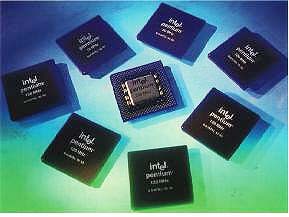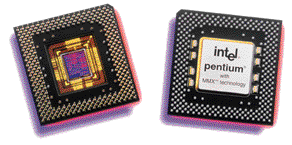CPU Guide
Problems With The 6x86 And The Solution
| Problem | Solution(s) |
| The 6x86 needs lots of power, more than a Intel Pentium. This leads to two different problems.The voltage regulator has to supply much more current, which some regulators are not up to. The regulators get very hot.The 6x86 CPU gets much hotter than a Pentium, which means that you have to take special precautions for good cooling of the CPU. I only can recommend the original Cyrix P200+ heat sink with fan, which is very good.There are so far three different voltage specifications of the single voltage 6x86.Type C028, which requires 3.52 VType C016, which requires 3.3 V'voltage switching' types, which can work with any of the above voltagesIt's a matter of fact, that at a lower voltage the chip needs less current and produces less heat. | There are two solutions from Cyrix to this problem6x86 of the revision 2.7 or higher need considerably less current or power than the previous versions. If you should want to buy a single voltage 6x86, you should at least get a revision 2.7 or higher.The 6x86L won't have this problem at all, since it runs at 2.8 V and needs under some conditions even less current than a Pentium of the same P-rating. This is the best 6x86 you can get. I wouldn't buy any other 6x86 model. |
| The 6x86 is very sensitive to reflections on the different buses. This was leading Microsoft to switch off the write back L1 cache of the 6x86 completely in Windows NT 4.0. This results in a serious performance decrease under this OS for 6x86 users. | There are also several different solutions to this problem:Cyrix offers a replacement to all registered NT4 users who are affected by this 25% performance decrease. Read more about this on Brian Davis' excellent 6x86 site .You also can download a software patch to enable the L1 cache again. However this *can* lead to instability under NT4.The revisions 2.7 and higher are not affected by this NT4 problem. You'll best get one of these or even better a 6x86L in the first place. |
| The FPU (Floating Point Unit) of the 6x86 is considerably slower than the FPU of the Pentium. A 6x86 P166+ has a FPU performance of a Pentium 90 only. This is something most people noticed in the game Quake. | Unfortunately there is no solution to this. Please consider however, that the FPU is only needed in very few applications like CAD or other calculating applications. It really depends on how important Quake is to you. It is expected, that more future games will use the FPU. Let's hope that the M2 will have a better FPU than the 6x86. |
Performance Enhancement Software
- 6xopt074.zip
- 6x86 optimizer written by Mikael Johansson. Configures 6x86 CPU registers to increase performance. Additionally it enables Windows95 to 'see' the 6x86 CPU in the device manager.
- directnt.zip
- Enables 6x86 cache under Windows NT 4. For all the Microsoft impaired NT users.
The Cyrix 6x86L CPU
I've been accused to be biased against the 6x86 by several people and to eventually end this stupid accusation I would like to explain myself.
The 6x86 CPU was not a child that came to the world and was making every person, that had to deal with it, happy straight away. The 6x86 had it's problems and Cyrix had to fight with a lot of trouble since the 6x86 release. However this doesn't say that Cyrix wasn't working extremely hard to survive by fixing one problem after the other. The latest improvement the 6x86 has received from its creator is the most pleasing one and eventually now I am happy with the 6x86 as well. The letter 'L' behind the CPU name is making all the difference to me and hopefully to all the possible 6x86 buyers as well.
The 'L' stands for 'low voltage' and doesn't say anything else as that the 6x86 now also has got the 'split voltage' feature known from the newly released Pentium MMX. Now for the Pentium this isn't making much of a difference, since the Pentium never had to fight any serious current or heat problems. For the 6x86 however, this could be the final liberation from his bad name as 'chip fryer'.
The 6x86L has just as the Pentium MMX a 2.8 V core and a 3.3 V I/O interface voltage. Cyrix expects a power reduction of more than 25% of the previous models, which will keep the CPU much cooler and won't ask for more current than a Pentium MMX.
This is probably the solution for all the people who have been scared by the recent problems with the 6x86. Unfortunately it comes a little bit late, since everyone is waiting for the M2 and the Pentium MMX 200 is much faster than a 6x86 P200+ (which is even on a lower level than the Pentium MMX 166 in most applications). However, who thinks that a P200+ is still by far fast enough and who doesn't want to spend as much money as for Intel CPUs, should get a 6x86L and nothing else. Getting an old 6x86 without the 'L' now is considered to be completely crazy, unless the old single voltage 6x86 shouldn't be considerably cheaper than the 6x86L.
The Intel Pentium Classic
Things You Should Know Before You Buy A Pentium
I don't think there's too much to say about the Pentium, because there's that much information already being released on the net and in magazines. However there's one important thing, which doesn't seem to be known too well. It's the fact that Pentiums of the same clock speed are not all the same, but can be VERY different, and you should know that before you get one ! There are now three reasons for that to be considered:
- Second class Pentiums, which require a higher voltage or are not capable of multi processing
- Intel is actually releasing different kinds of Pentiums. Some are not capable of multi processing, others have to have a higher supply voltage to run correctly. You have to realize, that Intel is not having a different production line for each clock speed, but is in real now producing more or less only one dye. After the chips have been produced, they are tested, and regarding how they performed in the test, the clock rates are chosen. Some chips would work correctly on a special clock rate only with a higher voltage, which means also getting hotter. Others wouldn't work with multi processing. To find out which kind of CPU you have or are offered, you have to have a look on the bottom side of the chip, where's written something like e.g. SK 106 SSS. These last three letters can tell you what kind of CPU you have, and here's the list . It's obvious, that you should try hard getting a chip, that runs at 3.3 V(S tandard) rather than 3.4 to 3.6 V (V RE), and maybe it makes you feel better to know that you've got a real Pentium, that works with multi processing as well, though you won't be able to use multi processing on a Triton board. If you should be into overclocking, it's almost inevitable to get a SSS-chip, because than you still can increase the voltage on the motherboard to get it running at a higher clock speed (as long as you cool it well!).
So again, have a look at the Pentium Processor Reference Table !!!
Get Tom's Hardware's best news and in-depth reviews, straight to your inbox.
- Pentiums with faked clock rate markings
- I don't know how big this problem is in the States, but in Europe there are a lot of faked Pentiums around. At the beginning, when Pentiums didn't have a marking at the bottom side as well, the CPUs were just grinded off, a new marking was lasered in and the writing was printed on it. This changed a Pentium 75 quick into a Pentium 90 or 100, and you only could find it out by actually measuring the thickness of the ceramic body in at least tenths of a millimeter (2.8 mm is the correct thickness), which would reveal the faked CPUs being slightly thinner. Now they additionally put absolutely real looking black stickers on the bottom of the chip as well. It's very hard to avoid being betrayed that way, but if you should buy one, at least try if you can remove a black label on the bottom of the chip, which reveals the real ceramic bottom side and the real marking. Only buy in shops that you can trust!!!
Additional Links
The Intel Pentium mmX
The Technical Advantages of the Pentium MMX over the Pentium Classic
- doubling of the L1 caches, 16 kB data and 16 kB instruction cache
- data cache now 4 way set associative - only 2 way set associative in Pentium classic
- doubling of the Write Buffers, now 4 instead of 2
- new branch prediction unit, taken from the Pentium Pro
- implementation of a Return Stack, as known from the Cyrix/IBM 6x86
- increase of the U and V Pipelines by one step
- improvement of the Parallel Processing Ability of the two pipelines
- the MMX instruction set with the ability to pair up two MMX instructions in one go, hence 2 SIMD instructions can be processed with 16 Byte data in one clock cycle
- new split voltage technology, 2.8 V for CPU core, 3.3 V for CPU I/O interface
Additional Links
- The Technical Manuals
- The Application Notes
- If you REALLY want to know what MMX is about, here you can have a look at the new MMX CPU instructions.
- For Assembler/Machine Code Freaks I found a link with all Mnemonics/Opcodes of all x86 CPUs . Maintained by Jesper Pedersen .
- Intel's MMX Speeds Multimedia
- Intel's Geography Lesson

